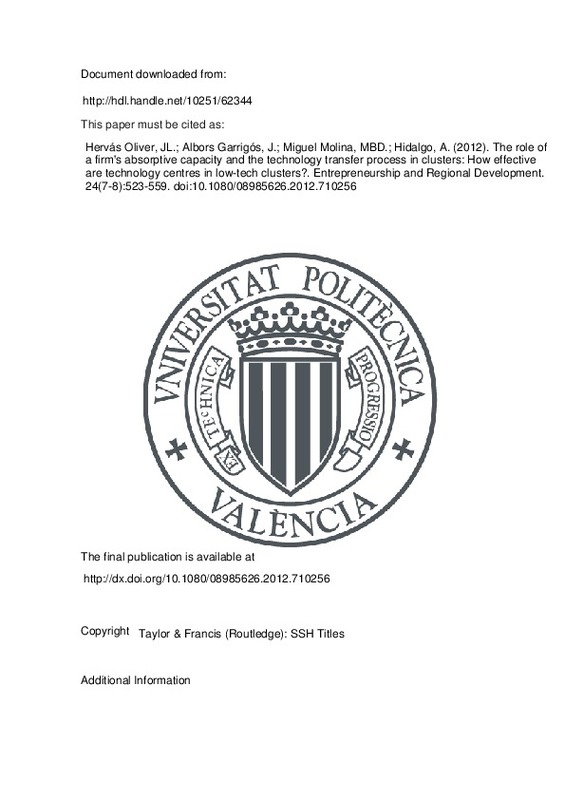JavaScript is disabled for your browser. Some features of this site may not work without it.
Buscar en RiuNet
Listar
Mi cuenta
Estadísticas
Ayuda RiuNet
Admin. UPV
The role of a firm's absorptive capacity and the technology transfer process in clusters: How effective are technology centres in low-tech clusters?
Mostrar el registro sencillo del ítem
Ficheros en el ítem
| dc.contributor.author | Hervás Oliver, Jose Luis
|
es_ES |
| dc.contributor.author | Albors Garrigós, José
|
es_ES |
| dc.contributor.author | Miguel Molina, María Blanca de
|
es_ES |
| dc.contributor.author | Hidalgo, Antonio
|
|
| dc.date.accessioned | 2016-04-07T14:13:29Z | |
| dc.date.available | 2016-04-07T14:13:29Z | |
| dc.date.issued | 2012-09 | |
| dc.identifier.issn | 0898-5626 | |
| dc.identifier.uri | http://hdl.handle.net/10251/62344 | |
| dc.description.abstract | [EN] This paper analyses how the internal resources of small- and medium-sized enterprises determine access (learning processes) to technology centres (TCs) or industrial research institutes (innovation infrastructure) in traditional low-tech clusters. These interactions basically represent traded (market-based) transactions, which constitute important sources of knowledge in clusters. The paper addresses the role of TCs in low-tech clusters, and uses semi-structured interviews with 80 firms in a manufacturing cluster. The results point out that producer-user interactions are the most frequent; thus, the higher the sector knowledge-intensive base, the more likely the utilization of the available research infrastructure becomes. Conversely, the sectors with less knowledge-intensive structures, i.e. less absorptive capacity (AC), present weak linkages to TCs, as they frequently prefer to interact with suppliers, who act as transceivers of knowledge. Therefore, not all the firms in a cluster can fully exploit the available research infrastructure, and their AC moderates this engagement. In addition, the existence of TCs is not sufficient since the active role of a firm's search strategies to undertake interactions and conduct openness to available sources of knowledge is also needed. The study has implications for policymakers and academia. © 2012 Copyright Taylor and Francis Group, LLC. | es_ES |
| dc.description.sponsorship | We thank the ECO: 2010-17318 Project Innoclusters funded by the Spanish Ministry of Science and Innovation (MICINN) for the period 2011–2013. In addition, Dr. Hervas-Oliver is thankful to Generalitat Valenciana GVA support for visiting London School of Economics (LSE, 2011 BEST programme GVA) during Fall 2011. | |
| dc.language | Inglés | es_ES |
| dc.publisher | Taylor & Francis (Routledge): SSH Titles | es_ES |
| dc.relation.ispartof | Entrepreneurship and Regional Development | es_ES |
| dc.rights | Reserva de todos los derechos | es_ES |
| dc.subject | Absorptive capacity | es_ES |
| dc.subject | Clusters | es_ES |
| dc.subject | Industrial research institutes | es_ES |
| dc.subject | SMEs | es_ES |
| dc.subject | Technology centres | es_ES |
| dc.subject | Innovation | es_ES |
| dc.subject | Manufacturing | es_ES |
| dc.subject | Research institution | es_ES |
| dc.subject | Small and medium-sized enterprise | es_ES |
| dc.subject | Technology transfer | es_ES |
| dc.subject.classification | ORGANIZACION DE EMPRESAS | es_ES |
| dc.title | The role of a firm's absorptive capacity and the technology transfer process in clusters: How effective are technology centres in low-tech clusters? | es_ES |
| dc.type | Artículo | es_ES |
| dc.identifier.doi | 10.1080/08985626.2012.710256 | |
| dc.relation.projectID | info:eu-repo/grantAgreement/MICINN//ECO2010-17318/ES/ANALISIS DE LA INNOVACION EMPRESARIAL A TRAVES DE LA CAPACIDAD DE ABSORCION TECNOLOGICA Y LA INTERACCION EMPRESA-CLUSTERS INDUSTRIALES: MEDICION DE LA INFLUENCIA MICRO EN LO M/ | es_ES |
| dc.rights.accessRights | Abierto | es_ES |
| dc.contributor.affiliation | Universitat Politècnica de València. Departamento de Organización de Empresas - Departament d'Organització d'Empreses | es_ES |
| dc.description.bibliographicCitation | Hervás Oliver, JL.; Albors Garrigós, J.; Miguel Molina, MBD.; Hidalgo, A. (2012). The role of a firm's absorptive capacity and the technology transfer process in clusters: How effective are technology centres in low-tech clusters?. Entrepreneurship and Regional Development. 24(7-8):523-559. https://doi.org/10.1080/08985626.2012.710256 | es_ES |
| dc.description.accrualMethod | S | es_ES |
| dc.relation.publisherversion | http://dx.doi.org/10.1080/08985626.2012.710256 | es_ES |
| dc.description.upvformatpinicio | 523 | es_ES |
| dc.description.upvformatpfin | 559 | es_ES |
| dc.type.version | info:eu-repo/semantics/publishedVersion | es_ES |
| dc.description.volume | 24 | es_ES |
| dc.description.issue | 7-8 | es_ES |
| dc.relation.senia | 226765 | es_ES |
| dc.identifier.eissn | 1464-5114 | |
| dc.contributor.funder | Ministerio de Ciencia e Innovación |







![[Cerrado]](/themes/UPV/images/candado.png)

